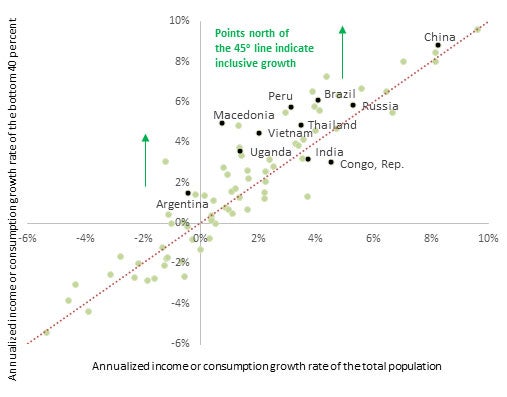Many advanced economies are experiencing rising income inequality which has raised questions about the benefits of globalization. Given the growing backlash against perceived job losses associated with the free movement of goods and people particularly in the US and Europe, economists and other development practitioners are renewing their efforts in making economic growth more inclusive and have focused their attention on how to share prosperity equitably. G20 – the international forum for the governments of 20 major economies – is calling its member nations to undertake policies and actions to make economic growth in their countries not only strong, sustainable and balanced, but also inclusive. Growth is inclusive when the poorer segments do at least as well as the overall population.
For us at the World Bank Group, this means we are focusing our efforts on boosting the income growth of the bottom 40 percent and have incorporated our goal to promote shared prosperity in every country. Before we look at policies that could promote inclusive growth, we need to know how countries have performed in expanding growth to the poor.
How inclusive is growth? Figure 1 presents the annualized growth in mean real income (or consumption, depending on the methodology of household survey data) currently circa 2008-13– for the bottom 40 percent (y-axis) and for the total population (x-axis). Each dot in the scatter diagram represents a country which shows its performance in growth reaching the poor; a few country specific performances are shown by a black dot and are marked.
FIGURE 1: Inclusive Growth: Evidence from Some Emerging Market & Developing Countries
(circa 2008-13)

Source: World Bank Global Database for Shared Prosperity.
The graph reveals several things: first, it shows that average income growth of the population and that of the bottom 40 percent tend to move closely together. This confirms the earlier research findings that indicate that overall growth is an important requirement for shared prosperity. A second observation is that countries that are above the 45 o line have experienced inclusive growth – that is, the bottom 40 percent of the population did better than the top 60 percent. The converse is true for countries which lie below the line. Third, for any given level of overall growth, points to the north of the 45 o line are preferred as it indicates the bottom 40 percent is benefiting more from growth.
As the graph shows, global progress on inclusive growth has been a mixed bag. Countries in the East Asia and Pacific and in the Latin America and the Caribbean regions have done well while the advanced economies have performed the least well. The World Bank’s 2016 report “ Poverty and Shared Prosperity 2016: Taking on Inequality” shares some experiences including policies that have been successful.
Policies for Inclusive Growth
A simple and straightforward way to promote inclusive growth is to ensure that the country grows at a strong and sustainable rate. How do we promote strong and sustainable growth in a country?
Policy research work done in the past – most notably the 2008 work of the World Bank supported Commission on Growth and Development – provides guidelines on a set of policies which could promote high growth. The building blocks for sustaining high growth over a long term and reaching high-income levels are:
Making rising growth more inclusive: What we know and what we do not?
How did countries manage to have its bottom 40 percent benefit more from growth? Can specific policies be pinpointed that could have assisted in making growth inclusive?
Currently there are no universal policy prescriptions available, which will ensure that if applied, countries will be able to boost inclusive growth. More research is needed in identifying and demonstrating the impact of such policies. But as detailed in the World Bank’s Poverty and Shared Prosperity 2016: Taking on Inequality report, evidence from some developing countries indicate that there are some policies and measures that can assist in making growth inclusive. For example, the following policies, if well-designed and well-implemented, could assist in promoting inclusive growth:
For us at the World Bank Group, this means we are focusing our efforts on boosting the income growth of the bottom 40 percent and have incorporated our goal to promote shared prosperity in every country. Before we look at policies that could promote inclusive growth, we need to know how countries have performed in expanding growth to the poor.
How inclusive is growth? Figure 1 presents the annualized growth in mean real income (or consumption, depending on the methodology of household survey data) currently circa 2008-13– for the bottom 40 percent (y-axis) and for the total population (x-axis). Each dot in the scatter diagram represents a country which shows its performance in growth reaching the poor; a few country specific performances are shown by a black dot and are marked.
FIGURE 1: Inclusive Growth: Evidence from Some Emerging Market & Developing Countries
(circa 2008-13)

Source: World Bank Global Database for Shared Prosperity.
The graph reveals several things: first, it shows that average income growth of the population and that of the bottom 40 percent tend to move closely together. This confirms the earlier research findings that indicate that overall growth is an important requirement for shared prosperity. A second observation is that countries that are above the 45 o line have experienced inclusive growth – that is, the bottom 40 percent of the population did better than the top 60 percent. The converse is true for countries which lie below the line. Third, for any given level of overall growth, points to the north of the 45 o line are preferred as it indicates the bottom 40 percent is benefiting more from growth.
As the graph shows, global progress on inclusive growth has been a mixed bag. Countries in the East Asia and Pacific and in the Latin America and the Caribbean regions have done well while the advanced economies have performed the least well. The World Bank’s 2016 report “ Poverty and Shared Prosperity 2016: Taking on Inequality” shares some experiences including policies that have been successful.
Policies for Inclusive Growth
A simple and straightforward way to promote inclusive growth is to ensure that the country grows at a strong and sustainable rate. How do we promote strong and sustainable growth in a country?
Policy research work done in the past – most notably the 2008 work of the World Bank supported Commission on Growth and Development – provides guidelines on a set of policies which could promote high growth. The building blocks for sustaining high growth over a long term and reaching high-income levels are:
- Creating and ensuring macroeconomic stability
- Investing in human capital & physical infrastructure
- Creating an enabling environment for competition and trade
- Improving and strengthening the financial system
- Facilitating structural transformation from agriculture to manufacturing, and from rural to urban
- Adopting modern technology and spurring innovation
- Building strong & effective institutions
- Enhancing environmental sustainability
Making rising growth more inclusive: What we know and what we do not?
How did countries manage to have its bottom 40 percent benefit more from growth? Can specific policies be pinpointed that could have assisted in making growth inclusive?
Currently there are no universal policy prescriptions available, which will ensure that if applied, countries will be able to boost inclusive growth. More research is needed in identifying and demonstrating the impact of such policies. But as detailed in the World Bank’s Poverty and Shared Prosperity 2016: Taking on Inequality report, evidence from some developing countries indicate that there are some policies and measures that can assist in making growth inclusive. For example, the following policies, if well-designed and well-implemented, could assist in promoting inclusive growth:
- Early childhood development
- Conditional cash transfer programs
- Universal access to good quality education
- Universal health care
- Enhanced infrastructure to connect lagging and poor regions
- Creating income-earning opportunities for the poor (e.g., access to finance)
_______________________
The interval circa 2008-2013 refers to the years in which the underlying household survey data were collected. The range of years refers to two survey collections, the most recent survey within the range and the nearest survey calculated five years before the most recent survey.
The interval circa 2008-2013 refers to the years in which the underlying household survey data were collected. The range of years refers to two survey collections, the most recent survey within the range and the nearest survey calculated five years before the most recent survey.


Join the Conversation